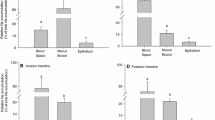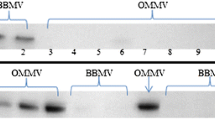Abstract
To investigate the fluxes of cationic amino acids beyond the proximal convolution, we micropunctured and microperfused superficial tubules of male Wistar rats in vivo et situ. In free-flow micropuncture experiments, the concentrations of endogenous L-arginine+, [Arg], and of intravenously infused L-homoarginine+, [HoArg], were determined by HPLC. Fluorescein isothiocyanatelabeled inulin was detected on-line in the same tubular fluid samples. To determine undirectional fluxes, radiolabeled Arg and inulin were (1) microperfused through short loops of Henle and (2) microinfused into different tubule segments to measure urinary recovery of the radiolabel. At a mean [Arg]plasma of 116 μmol/l, [Arg] was 9.3 μmol/l in the late proximal tubule (LPT), and 35.6 μmol/l in the early distal tubule (EDT) corresponding to fractional deliveries (FD) of 0.055 in LPT and 0.078 in EDT. Fractional urinary excretion (FE) of Arg was 0.00033 (P<0.05 vs FDEDT). Infusion of HoArg (2.5 or 7.5 μmol/min) led to respective mean [HoArg]plasma values of 1.44 and 3.73 mmol/l, and resulted in respective FDLPT values for HoArg of 0.23 and 0.53, respective FDEDT values of 0.29 and 0.41, and finally, respective FE values for HoArg of 0.25 and 0.58. When short loops of Henle were microperfused with 1 or 50 mmol/l [14C]Arg (+[3H]inulin), fractional recovery (FR) of 14C (relative to inulin) in the EDT was 0.13 and 0.36, respectively. During microinfusion of radiolabeled Arg (1 or 50 mmol/l) and inulin into LPT, the urinary FR of the radiolabel was 0.14, or 0.59, respectively. If 0.007, 1 or 50 mmol/l radiolabeled Arg were microinfused into EDT, the respective urinary FR of the radioactivity was 1.02, 1.10, or 1.01. Microperfusion of microinfusion of 1 mmol/l [14C]Arg plus 50 mmol/l HoArg resulted in a FREDT of 14C of 0.43 (loop, perfusion) and an FE for 14C of 0.69. Five conclusions can be drawn. First, cationic amino acids can enter and leave the lumen of short loops of Henle through specific carrier(s) at high rates, although, secondly, net transport is small or absent. Thus, medullary tubule cells can be supplied with Arg from the lumen of short loops of Henle for urea and nitric oxide production. Thirdly, the distal convolution of superficial nephrons and the collecting duct are not permeable to Arg. Thus, fourthly, the difference between FDEDT and urinary FE of Arg must be explained by an inter-nephron heterogeneity between deep and superficial nephrons. Finally, the process responsible for the different Arg handling in deep nephrons is not accessible to HoArg or, if so, it is saturated at millimolar concentrations.
Similar content being viewed by others
References
Andreucci VE (1978) Surgery in the rat. In: Andreucci VE (ed) Manual of renal micropuncture. Idleson, Naples, pp 50–86
Bergeron M, Morel F (1969) Amino acid transport in renal tubules. Am J Physiol 216:1139–1149
Brezis M, Heyman SN, Dinour D, Epstein FH, Rosen S (1991) Role of nitric oxide in renal medullary oxygenation. Studies in isolated and intact rat kidneys. J Clin Invest 88:390–395
Carlisky NJ, Jard S, Morel F (1966) In vivo tracer studies of renal urea formation in the bullfrog. Am J Physiol 211:593–599
Dantzler WH, Silbernagl S (1990) Amino acid transport: microinfusion and micropuncture of Henle's loops and vasa recta. Am J Physiol 258:F504-F513
Dantzler WH, Silbernagl S (1993) Basic amino acid transport in renal papilla: microinfusion of Henle's loops and vasa recta. Am J Physiol 265:F830-F838
Deetjen P, Silbernagl S (1972) Some new developments in continuous micro-perfusion technique. Yale J Biol Med 45:301–306
Eisenbach GM, Weise M, Stolte H (1975) Amino acid reabsorption in the rat nephron. Free flow micropuncture study. Pflügers Arch 357:63–76
Gekle M, Silbernagl S (1991) Basolateral uptake and tubular metabolism of L-citrulline in the isolated-perfused non-filtering kidney of the African clawed toad (Xenopus laevis) Pflügers Arch 419:492–498
Günther R, Silbernagl S, Deetjen P (1979) Maleic acid induced aminoaciduria. Studies by free flow micropuncture and continuous microperfusion. Pflügers Arch 382:109–114
Kettner A, Silbernagl S (1985) Renal handling of citrulline. In: Dzurik R, Lichardus B, Guder W (eds) Kidney metabolism and function. Martinus Nijhoff, Dodrecht, pp 51–60
Levillain O, Hus-Citharel A, Morel F, Bankir L (1989) Production of urea from arginine in pars recta and collecting duct of the rat kidney. Renal Physiol Biochem 12:302–312
Levillain O, Hus-Citharel A, Morel F, Bankir L (1990) Localization of arginine synthesis along rat nephron. Am J Physiol 259:F916-F923
Levillain O, Hus-Citharel A, Morel F, Bankir L (1992) Localization of urea and ornithine production along mouse and rabbit nephrons: functional significance. Am J Physiol 263:F878-F885
Lindner G, Foulkes EC (1985) Kinetics of renal reabsorption and its inhibition by metals in the intact rat kidney. Environ Res 36:241–247
Mullins Von Dreele M, Banks RO (1985) Urea synthesis in the canine kidney. Renal Physiol Biochem 8:73–79
Radermacher J, Klanke B, Kastern S, Haake G, Schurek H-J, Stolte HF, Fröhlich JC (1991) Effect of arginine depletion on glomerular and tubular kidney function: studies on isolated perfused rat kidneys. Am J Physiol 30:F779-F786
Rogers QR, Freedland RA, Symmons RA (1972) In vivo synthesis and utilization of arginine in the rat. Am J Physiol 223:236–240
Roth M (1971) Fluorescence reaction for amino acids. Anal Chem 43:880–882
Roth M, Hampai A (1973) Column chromatography of amino acids with fluorescence detection. J Chromatogr 83:353–356
Silbernagl S (1983) Kinetics and localization of tubular resorption of “acidic” amino acids. A microperfusion and free flow micropuncture study in rat kidney. Pflügers Arch 396:218–224
Silbernagl S (1992) Tubular transport of amino acids and small peptides. In: Windhager EE (ed) Handbook of physiology, section 8: renal physiology. Oxford University Press, New York, pp 1937–1976
Silbernagl S, Deetjen P (1972) L-Arginine transport in rat proximal tubules. Microperfusion studies on reabsorption kinetics. Pflügers Arch 336:79–86
Silbernagl S, Deetjen P (1973) Molecular specificity of the L-arginine reabsorption mechanism. Microperfusion studies in the proximal tubule of rat kidney. Pflügers Arch 340:325–334
Silbernagl S, Gekle M, Völker K, Braun E, Dantzler WH (1991) Pump, leak and metabolism: postproximal handling of amino acids in the kidney. In: Hatano M (ed) Nephrology. Springer, Berlin Heidelberg New York, pp 1408–1416
Silbernagl S, Völker K, Dantzler WH (1994) Cationic amino acid fluxes beyond the proximal convoluted tubule. A micropuncture study in the rat (abstract). Pflügers Arch 426:R130
Sonnenberg H, Deetjen P (1964) Methode zur Durchströmung einzelner Nephronabschnitte. Pflügers Arch 278:669–674
Terada Y, Tomita K, Nonoguchi H, Marumo F (1992) Polymerase chain reaction localization of constitutive nitric oxide synthase and soluble guanylate cyclase messenger RNAs in microdissected rat nephron segments. J Clin Invest 90:659–665
Author information
Authors and Affiliations
Rights and permissions
About this article
Cite this article
Silbernagl, S., Völker, K. & Dantzler, W.H. Cationic amino acid fluxes beyond the proximal convoluted tubule of rat kidney. Pflugers Arch. 429, 210–215 (1994). https://doi.org/10.1007/BF00374314
Received:
Revised:
Accepted:
Issue Date:
DOI: https://doi.org/10.1007/BF00374314




